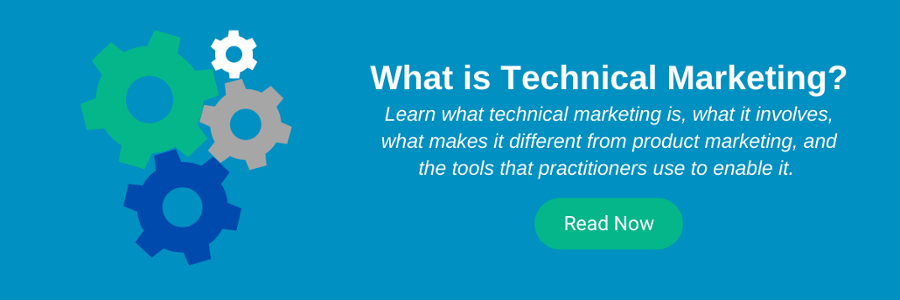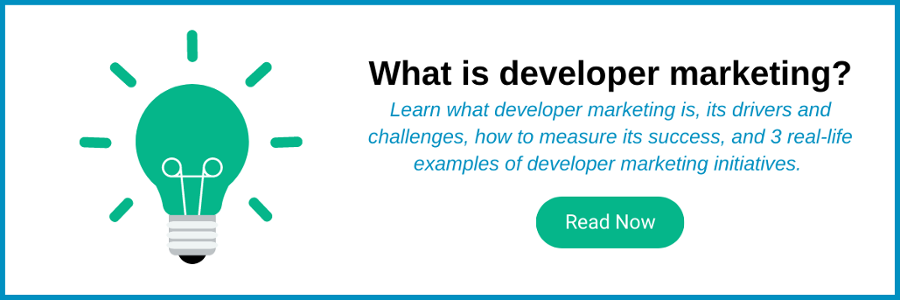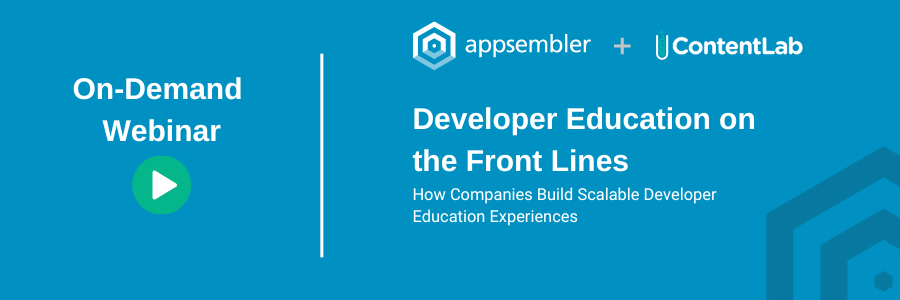Early on in my career, I got involved in an open-source project, and one of my main takeaways from being deeply immersed in open-source communities is that education was not seen as a nice to have. It was seen as an essential part of the developer experience. This had a profound impact on how I think about the value of education and technical marketing to grow a company and a community.
My mission is to help companies big and small build and scale their developer education programs, so I was excited to take part in a recent webinar between Appsembler’s CEO, Nate Aune, and ContentLab’s Ryan Peden. In this webinar, they discussed several topics regarding developer education that I’ve tried to distill into its top 5 actionable tips and best practices.
Tip 1: Create a Holistic Content Plan
Blogs and tutorials are an important part of any educational developer marketing experience; they are often a developer’s first point of contact with your product, and developers love documentation. But they are also anonymous; you don’t know who is reading them and you can’t reach out and contact them.
Instead of solely focusing on this kind of content, you should use blogs and tutorials as part of a holistic content plan that covers all aspects of the developer’s journey. Think of them as stepping stones to encourage your developers to become learners and sign up for your courses.
Self-paced courses are an ideal next step in the funnel, as you can start gathering extra data on your developers to understand who they are and if “clusters of learners” are beginning to form around your product (clusters can form within companies, developer groups/communities, universities, or even countries/regions). Your content will work better when you build content for the clusters that show the highest interest in your product. This bottom-up approach to content creation means your content will strengthen and reinforce the developers that are expressing the most interest in your product.
Tip 2: Unify Your Developer Marketing Department
I’ve seen a lot of companies that have siloed departments; their marketing, developer relations, and training teams all operate independently. They often all create separate pieces of content for different stages of the developer journey. But if they’re not talking to each other, then they aren’t effectively creating a learning path that will lead to the desired outcome (product adoption).
You need a unified developer marketing department if you want to keep learners moving through the funnel and encourage them to take the next step in the learner journey.
It’s important to think about the entire developer learner journey rather than asking different departments to deal with awareness, engagement, community, and activation. A unified developer marketing department can work together to attract developers’ attention, get them to visit your website, read your blog posts, enroll in a course to learn how to use your product, and eventually to sign-up for a free product trial.
Tip 3: Think of Developer Education as Marketing
We’ve talked to companies that have created good developer marketing initiatives and good developer education programs, but these programs are often siloed, run separately, and compete for the same budgets.
While keeping developer education and marketing separate can work, you’re missing a huge opportunity if you’re not thinking about using education as a form of marketing. If you bring together developer education and developer marketing under one roof, in one team, the whole will be greater than the sum of its parts.
After all, developer marketing isn’t really marketing. You aren’t going to win over any developers through cold calls, static demos, and fact sheets. The best kind of developer marketing is educational because we know that developers don’t respond well to most forms of traditional marketing, but prefer hands-on product sandboxes, sample code, product documentation, courses, and tutorials.
Tip 4: Create a 360-Degree View of Developers
If you want to run a successful developer marketing and education program, you need to see all your data behind a single pane of glass. This means tracking developers’ progression through the entire funnel and each touchpoint using a single source of truth. The data you should unify includes:
- Website visits
- Blog and tutorial views
- Course enrollment
- Course progression
- Course completion
- Free trials
Creating this 360-degree view of the entire journey enables you to drive engagement and keeps you on developers’ radars as you know what they’re up to at any given moment. You can use this data to trigger email campaigns, to reach out to developers to nudge them about homework deadlines, or upcoming workshops and courses. You create useful, personalized, and relevant email campaigns rather than trying to sell a product.
Tip 5: It’s Not All About Your Product
It can be tempting to focus all your developer education efforts on your product, but there is a better way to gain developer trust. Creating courses about peripheral technologies has been a successful strategy for companies running developer education programs, such as Chef Software.
Chef found that creating general DevOps courses helped improve their brand’s recognition with developers. With Chef’s DevOps courses, developers got the sense that Chef was a developer-friendly company that understood what developers wanted. Developers could see that Chef provided value to the community without expecting anything in return.
For example, if developers need to know Ruby before they can use your product, then creating an “Introduction to Ruby” course is a great way to attract the attention of developers who have never heard of your product. When a developer searches for “introduction to Ruby”, your course will be displayed on the search engine results page. Developers will become more familiar with your brand and you’ll be top of mind when they are searching for a product to solve their problems. What might also happen is after developers take your “Introduction to Ruby” course, they’ll rollover into your product course to learn more about your company and its offerings.
If you want to find out more about the topics we discussed and get more advice, listen to a replay of the webinar here:








